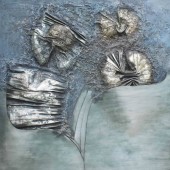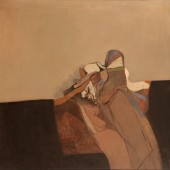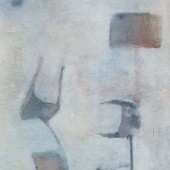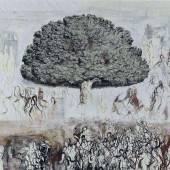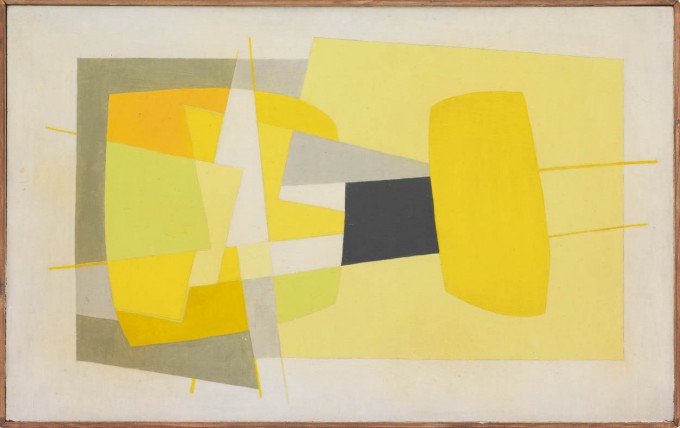
This vibrant work, Composition in Yellow, demonstrates Saloua Raouda Choucair’s approach to abstraction: straight lines cut across the pictorial surface, dissecting geometric shapes and creating new ones, producing a magnetic composition that is balanced yet refuses stillness. Choucair’s use of three different tones of yellow further adds a sense of depth to the two-dimensional panel by creating the effect of layering and light. Choucair was one of the earliest artists in the region to work in abstraction and her unique, deeply intellectual and holistic approach that combines inspiration from mathematics, philosophy, science, Islamic art, architecture, and spirituality, and modernism renders her a critical figure in global art history.
Born in Beirut in 1916, Choucair was a prolific artist, producing architectural plans, fountains, housewares, and jewellery in addition to painting and sculpture. She studied the natural sciences at the American Junior College for Women from 1934 to 1936, graduating from the Beirut College for Women in 1938 and training in the ateliers of Lebanese artists Moustafa Farroukh and Omar Onsi. In 1948, Choucair moved to Paris to pursue formal art training at the École des Beaux-Arts and trained in the studio of Fernand Léger. In 1950, her inclination toward geometric shapes and Arabic letters led her to organise L’Atelier de l’Art Abstrait with other avant-garde artists. During this time Choucair created her first non-objective works, showing early experimentation with repeated forms. She returned to Beirut in 1951. In 2011, the Beirut Art Center honoured her career with a retrospective as did the Tate Modern in London in 2013.
يبرز هذا العمل النابض الأسلوب التجريدي للفنانة سلوى روضة شقير: حيث الخطوط المستقيمة تقطع السطح التصويري وتشرّح الأشكال الهندسية لتنشئ أشكالاً جديدة، وتنتج تركيبة جذابة متوازنة وإن كانت ترفض السكون. ويضيف استخدام شقير لثلاث درجات مختلفة من اللون الأصفر مزيداً من الإحساس بالعمق إلى اللوحة ثنائية الأبعاد عبر خلق تأثير الطبقات والضوء. كانت شقير واحدة من رواد التجريد في المنطقة، واتسمت بنهجها الفكري العميق والشامل الذي يستقي إلهامه من الرياضيات والفلسفة والعلوم والفن الإسلامي والعمارة والروحانيات والحداثة، وهذا ما يجعلها شخصية محورية في تاريخ الفن العالمي.
ولدت الفنانة شقير في بيروت عام 1916، وكانت فنانة معطاءةً أنجزت العديد من المخططات المعمارية ونوافير المياه والأدوات المنزلية والحلي بالإضافة إلى أعمالها في مجالي الرسم والنحت. ودرست شقير العلوم الطبيعية في “الكلية الأمريكية للبنات” (1934-1936)، وتخرجت من “كلية بيروت للبنات” عام 1938 وتدرّبت في مراسم الفنانين اللبنانيين مصطفى فروخ وعمر أنسي. وفي عام 1948، انتقلت شقير إلى باريس لمتابعة تعليمها الرسمي في “المدرسة الوطنية للفنون الجميلة”، وتدربت في استوديو “فرناند ليجيه”. وفي عام 1950، ساقها ميلها نحو الأشكال الهندسية والحروف العربية إلى المساهمة في تدشين “محترف الفن التجريدي” مع فنانين آخرين. وخلال هذه الفترة، أنجزت شقير أول أعمالها غير الموضوعية عبر تجريب أشكال متكررة، وبعدها عادت إلى بيروت في عام 1951. وفي عام 2011، كرم “مركز بيروت للفنون” مسيرتها الفنية بتنظيم معرض استعادي لأعمالها، وكذلك فعل متحف “تيت مودرن” في لندن عام 2013.




